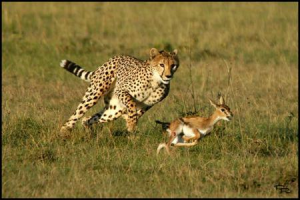The Feeding Behavior Of Cats

When I was a little girl my family had a big, ole orange-colored tomcat named Ginger. He was an indoor/outdoor cat. In other words, he was let out at night to do what felines do best: roam the neighborhood and do his tomcat thing. And every other morning we would find a dead mouse lying on the front door welcome mat. We were appalled and fascinated at the same time.
“Ah, look. Ginger has left us a present.” I’d say.
And, my dad would answer. “Yes, he’s showing us some love by bringing home dinner.”
But is that what my cat was really doing? Showing his humans “some love?” Well, in a way, yes…and, no.
Wildlife vs Cats
A study published in Nature (September 2012) wrote that every year in the U.S., our free-roaming house cats kill an estimated 6.9 to 20.7 billion mammals. Plus, an additional 1.4 to 3.7 billion birds. Wow! That’s a heck of a lot of wildlife. This has caused some bird-lovers to declare “war” on cats.
In 2011, Nico Dauphine, a postdoctoral fellow with the Smithsonian Migratory Bird Center at the National Zoo, was arrested for animal cruelty when she was caught on surveillance camera allegedly poisoning a colony of feral cats in Columbia Heights, DC (See Story). Dauphine denied the charges, but it was no secret she wasn’t a fan of cats. In 2009, she gave an online lecture entitled, “Apocalypse Meow: Free-ranging Cats and the Destruction of American Wildlife” which discussed how feral cats kill billions of animals in the U.S. each year.
In 2011, Dauphine was found guilty of attempted animal cruelty (See Story).
Recently, the Australian government announced plans to cull up to 2 million feral cats in an attempt to “protect Australia’s native mammal and bird populations.” They have listed feral cats as “pests” and are being blamed for the extinction of 29 indigenous species and a threat to another 1,800 species (See Story).
Free Roaming Cat Study
From November 2010 to October 2011, the University of Georgia and the National Geographic Society worked together to investigate what house cats in Athens, Georgia were doing when they were let out of the house. So, they attached light-weight cameras to the collars of 60 free-roaming domesticated cats and recorded their adventures. And, what did they find?
44% of the cats hunted wildlife with an average of 2 prey caught per 7 days (Lizards and Woodland Voles were the most common prey caught). 21% of their kills were brought home. 30% were eaten. And, 49% of kills were not eaten at all.
The study pointed out that all 60 cats were fed before being let out of the house (Read the study HERE).
Dogs aren’t so innocent either. And, if allowed to free-roam, dogs will also kill animals. I can remember an incident a few years ago where a “wolf pack” of dogs went on a hunting spree throughout the neighborhood and killed dozens of cats, possums, and squirrels. For weeks afterward, my neighbors and I were picking up kitty parts out of our flower beds and bushes.
Plus, I have clients who live in the countryside and allow their dogs to free-roam over the meadows and woods. When the dogs came home they were often covered in skunk stink, porcupine quills, and blood covered muzzles. Obviously, these dogs wanted to taste some wildlife. But, since there are laws against free-roaming dogs, most people—especially city-dwellers—don’t let their dogs loose in the neighborhood. So, I doubt we’re going to have any studies or doggy-cams to see what dogs like to do on their off-leash nature walks.
A Simple Pleasure: The Hunt
Now, getting back to the killer kitty studies…
What gets me is the researchers scratch their heads and say they don’t understand why a well-fed house cat would kill if it’s not hungry. The usually answer is “Well, they’re predators. It’s instinct.” But instinct just teaches them how to hunt and what food to hunt. So, there has to be something else. What’s missing? Well, we can give our cats the best pet food and all the love in the world, but what we can’t give our domesticated cats (and dogs) is the “pleasure of eating.”
And what do I mean by the “pleasure of eating”?
Well, how do humans find pleasure in eating? First, there is the aroma of our favorite foods or spices that can trigger pleasant memories. Or, the calming effect of preparing food in the kitchen and the satisfaction of friends and family enjoying your cooking. The rituals of setting the table with your best china, or creating the mood with decorations or candles. Or, how about an upscale fancy restaurant with attentive waiters and plates of food arranged like works of art. For us, food can comfort us, awake our senses, and work as an aphrodisiac. We really enjoy our food! Well, heck. Humans don’t have a big brain and 10,000 taste buds for nothing.
But imagine if we ate our food in a pill or from a tube. Yeah, our stomachs might be full, and maybe we’d get some nutrients… but, where’s the pleasure?
When we feed our pets what do we do? We open a can, or prepare a homemade diet, and plop it in a bowl. You may have noticed this, or maybe not, but animals don’t savor their food. You’re not going to see your dog roll the meat around in his mouth, close his eyes, and go “Mmmmm, yummy.” He just swallows it in one gulp. Or, like my cats, inhale their dinner in 30 seconds. Yeah, the dog/cat’s stomach is full, he’s getting all his nutrients. But where’s the mental stimuli? Where’s the joy?
INTO THE WILD
Cats in the wild behave differently than cats in captivity (are not domesticated cats in captivity?). And when wild cats are placed in captivity they usually end up behaving like our domesticated house cats. It didn’t matter how big or small the enclosure was the activity was the same: The Big Cat would find a nice spot to sit and sleep all day until the keepers brought them some food. The Big Cat would eat, and when he finished he’d go back to his resting spot, sit, and sleep some more.
The San Diego Wild Animal Park in California found this problematic in the breeding of cheetahs in captivity. The psychological impact of a sedentary life and its correlation with the consumption of food affected the reproduction success of the wild cats. However, the park keepers did notice behavioral changes when the food was presented to the cats that closely resembled a wild prey. For example: In many zoos, the Big Cats are fed ground raw meat that is squeezed out of tubes.
The ground meat provided nutrients and satiety, but not much enthusiasm (not to mention an increase in mouth and nasal passage infections due to soft food can’t clean teeth). But when the cats were fed a full carcass, such as, a slaughtered cow, the cats displayed “improved appetites, a tenacity towards possession of food, and even bouts of play centered around the carcass.” (Ref)
But, is that enough mental stimuli?
Four Phases Of The Hunt
Big Cats in the wild have been studied for years by Wildlife Researchers. They have observed that Big Cats feeding habits are divided into four phases: Seeking out the location of prey, capture tactics, the killing act, and behavior at the kill. Wild cats can walk 10 or 20 miles a day just looking for food. Most of the time the cat will find nothing and when they do finally locate prey they’re not always successful in the chase & catch.
A solitary hunter like a tiger will have 1 kill out of 20 attempts. Lions, especially the lioness, will hunt in a group of two or more and will be successful in 1 out of 5 attempts (or, 13%-17% success rate). Also, lions will zero in on the behavior of vultures and hyenas to find a food source which reduces search time. Compared to a tiger, a cheetah will have a higher success rate of 50%-70% in the chase & catch. However, they will often lose their kill to other predators.
An interesting note: cheetahs ignore prey that won’t flee. This is an animal famous for its speed, so the chase seems to be a big deal in their “fun.” Other Big Cats settle for the stalking and ambush rather than a calorie-burning, energy exerting chase. The chase must be exhausting, because the cheetah will rest 30-minutes or more before eating its kill.
The Big Cat uses its weight and strength to bring down a big prey, grab it by the throat, and either strangle or break its neck. The cats rarely, if not at all, eat the prey at the site of the kill. Instead, the kill is dragged a distance away either “to seek shade or cover, to protect the kill from other predators, or to be near water or a litter of cubs.”
(Ref) Maybe this is why Ginger would bring his dead mouse home! Some cats, like the tiger and mountain lion, will cache their food. They’ll eat some meat in one sitting and save the remains for a later feeding by hiding the carcass under brush and leaves.
BIG CAT, LITTLE CAT
The bottom line is housecats hunt and kill wild life because it’s a mental stimuli. It gives them pleasure. The point of this blog is to not be upset when the cat brings home a dead mouse, but to understand the true nature of the cat.
Cats are a very impressive and highly efficient predator. They can hear ultrasonic sounds to track the movement of rodents and other small prey. Their visual field covers approximately 200 degrees. Cats see better in low light, and better with movement. As they move closer to their prey their whiskers take over. The large, round eyes of cats cannot focus on objects 12-inches or less from their face. To make up for this, the whiskers serve as a sonar that provides a 3-D “picture” of what is in front of their nose.
What Can You Do
So, how do we stop roaming house cats from killing birds and small mammals? Well, it is impractical, if not impossible, for the cat owner to duplicate the “wild hunt.” So, in order to protect wild life other solutions are offered. First, you can stop your cat from free-roaming. But if Ginger is used to going outside and you change his routine then expect your blinds, curtains, and screen doors to be scratched to pieces.
I have a friend who trained her cat to walk on a leash (I’ve never been successful at walking my cats on a leash. So this idea may be impractical for most). You could have supervised outdoor time. Well, that is, until the cat climbs a fence and takes off. Or, how about an Outdoor Cat Run (That should look attractive in your backyard). Some suggest the cats could wear a bell on their collar to alert birds and other small mammals of an approaching cat. Or, perhaps a BirdsBeSafe collar, which looks like a bib. The idea is the bright colors on the bib will supposedly alert the birds and they’ll fly away.
Reading:
Don’t Blame Cats For Destroying Wildlife—Shaky Logic Is Leading To Moral Panic
How To Stop Cats From Killing Birds
Reference: “Improving the Feeding of Captive Felines Through Application of Field Data” by D.G. Lindburg, Research Department, Zoological Society of San Diego, San Diego











